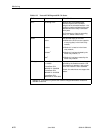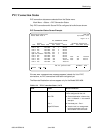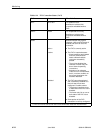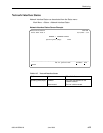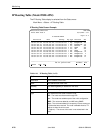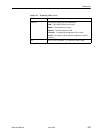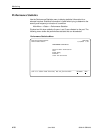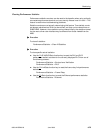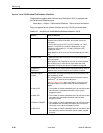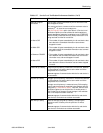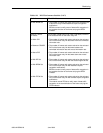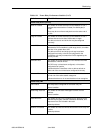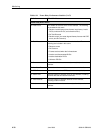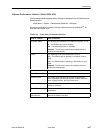
Monitoring
6-30
9820-A2-GB20-20
June 2000
Service Level Verification Performance Statistics
These statistics appear when Service Level Verification (SLV) is selected from
the Performance Statistics menu.
Main Menu
→
Status
→
Performance Statistics
→
Service Level Verification
They only appear for the network interface and only if DLCIs are multiplexed.
Table 6-17. Service Level Verification Performance Statistics (1 of 2)
Statistic
What It Indicates
Far End Circuit Number of the multiplexed DLCI or VPI/VCI (Virtual Path
Identifier/Virtual Channel Identifier) at the other end of the
connection.
If the far-end circuit is a DLCI, the DLCI number (16–1007)
appears. If a VPI/VCI, the number is displayed as
xx,yyy,
xx being the VPI number (0 –15) and
yyy
being the VCI
number (32–2047).
None appears if the unit has not communicated with the other
end.
Far End IP Addr IP Address of the device at the other end of the multiplexed
DLCI connection.
None appears if the FrameSaver unit has not communicated
with the other end, or if the device at the other end of the
multiplexed DLCI does not have an IP Address configured.
Dropped SLV
Responses
The number of SLV inband sample messages sent for which a
response from the far-end device has not been received.
Inbound Dropped
Frames
Total number of frames transmitted by the far-end device that
were dropped in transit.
The counts continue to increment until the maximum value is
reached (2
32
–2), then the count starts over.
The SLV Delivery Ratio option (see Table 4-3, Service Level
Verification Options) must be enabled for these statistics to
appear.
H Above CIR H The number of frames transmitted by the far-end device that
were above the committed information rate and were
dropped in transit.
H Within CIR H The number of frames transmitted by the far-end device that
were within the committed information rate, but were
dropped in transit.
H Between CIR&EIR H The number of frames transmitted by the far-end device that
were between the committed information rate and excess
information rate, and were dropped in transit.
H Above EIR H The number of frames transmitted by the far-end device that
were above the excess information rate and were dropped
in transit.



